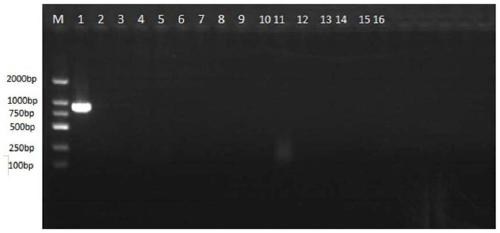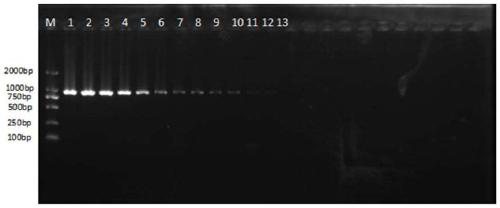PCR detection primers for klebsiella as pathogeny of mulberry bacterial wilt disease and application of PCR detection primers
A technology for Klebsiella and detection primers, which is applied in the determination/inspection of microorganisms, microorganisms, and recombinant DNA technology, etc., can solve the problems affecting the quarantine and prevention of diseases, and achieve the effect of good application value and good detection effect.
- Summary
- Abstract
- Description
- Claims
- Application Information
AI Technical Summary
Problems solved by technology
Method used
Image
Examples
Embodiment 1
[0050] Example 1 Establishment of PCR Molecular Detection Method for Mulberry Bacterial Fusarium Wilt Pathogen Klebsiella
[0051] 1. Experimental method
[0052] 1. Extraction of Klebsiella genomic DNA
[0053] The DNA of bacterial pathogenic bacteria was extracted using the method of Ezup Column Bacterial Genomic DNA Extraction Kit. For the extraction method, please refer to the kit instruction manual.
[0054] 2. Primer design and reaction system and procedures
[0055] According to the BLASTn comparison of the whole genome sequence of Klebsiella and the nucleic acid sequences of other similar species published on NCBI, specific gene sequences were selected to design specific primers. The results of setting specific primers for the specific gene sequence of Klebsiella sp are shown in Table 1.
[0056] Table 1:
[0057]
[0058] 3. Primer reaction temperature optimization
[0059] The PCR reaction amplification system is shown in Table 2. The amplification program i...
Embodiment 2
[0064] Embodiment 2 A kind of mulberry bacterial wilt pathogen Klebsiella specific detection kit
[0065] 1. Composition
[0066] The nucleotide sequence is as shown in SEQ ID NO: 1-2 primers, 2×Taq Master Mix and ddH2O.
[0067] 2. How to use
[0068] 1. Extract the DNA of the sample to be tested
[0069] (1) Sample plant DNA extraction
[0070] The root tissue of the freshly collected mulberry plant was rinsed with sterile water, dried naturally, and cut into root segments of about 3-4 cm. Add 75% alcohol to the funnel on the clean workbench, soak for about 15 seconds, drain the alcohol, treat it with mercuric chloride for 5 minutes in the same way, and rinse it with sterile water for 3 to 4 times, take out the root segment and place it on the workbench to air dry , use sterile tweezers to tear off the cortex of the root segment to expose the wood, then use a sterile scalpel to cut and scrape the longitudinal strips of the xylem, place them in a sterile mortar, add about...
Embodiment 3
[0078] Embodiment 3 Mulberry bacterial wilt pathogen PCR specific detection
[0079] 1. Experimental method
[0080]Enterobacter cloacae, Pantoea ananatis, Kosakonia sp, Pseudomonas sp, Paenibacillus polymyxa, Bacillus subtilis, Curtobacterium sp, Ralstonia solanacearum, Serratia marcescens, P. aeruginosain, Cladosporium perangustum, Oxysporum The genomes of 14 strains of Fusarium oxysporum, Auricum polytricha, and Fusarium equiseti were used as templates, and the genome of Klebsiella sp was used as a positive control, and sterile water was used as a template. Negative control, detect according to the method of embodiment 2.
[0081] 2. Experimental results
[0082] Depend on figure 2 It can be seen that the primer has good specificity and can only amplify Klebsiella sp. The target band size is about 920bp (see lane 1), and cannot amplify other bacterial strains.
PUM
 Login to View More
Login to View More Abstract
Description
Claims
Application Information
 Login to View More
Login to View More - R&D Engineer
- R&D Manager
- IP Professional
- Industry Leading Data Capabilities
- Powerful AI technology
- Patent DNA Extraction
Browse by: Latest US Patents, China's latest patents, Technical Efficacy Thesaurus, Application Domain, Technology Topic, Popular Technical Reports.
© 2024 PatSnap. All rights reserved.Legal|Privacy policy|Modern Slavery Act Transparency Statement|Sitemap|About US| Contact US: help@patsnap.com










